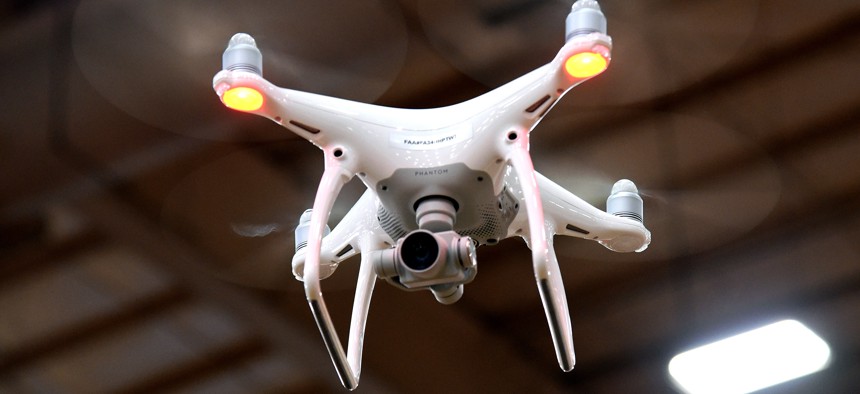New Chinese research examines how to get drones to target without GPS

A DJI Phantom 4 drone is flown during an AviSight Drone Academy training class at the South Point Hotel & Casino on August 26, 2016 in Las Vegas, Nevada. Ethan Miller/Getty Images
But camera data can’t tell a drone whether hitting a target is a bad idea.
A recent academic paper out of China proposes a new method for controlling drones and steering them to targets in environments where GPS is under attack, a new sign of the growing importance of drones in conflicts where adversaries have advanced electromagnetic jamming capabilities.
The paper, published at the end of July in the journal Engineering, proposes using data from the drone’s cameras to estimate things like how quickly a target is moving (target velocity) and the target’s position.
Using camera data, rather than GPS, to help robots target objects isn’t new. The concept has been around since 1980. But as robot computer processing, algorithms, and camera sensors have improved, so have the things that robots can effectively see. Now, vision-based robot control allows robots to do things like play table tennis, for instance.
But it’s hard to imagine needing to steer drones in a GPS-denied environment for non-military reasons. (U.S. operators have had drones that work in GPS-denied environments for years.) In effect, the formula allows the drone to decide for itself where the target is, but the drone can’t make decisions like whether hitting the target might cause harm to innocent humans. Whether that drone is armed is, of course, up to the operator. But the breakthrough does demonstrate a growing reliance on artificial intelligence and autonomy in drones in order to destroy targets, as advanced hacking and jamming techniques render human-controlled drones less useful on the battlefield, said Peter Singer a strategist at New America and the author of multiple books on technology and security.
“The days of a human joysticking a drone from afar, using an unchallenged control signal and easy access to GPS or StarLink, are on their way out. It was easy to see this trend before Ukraine; what is happening there only reinforces it,” Singer said.
But if being able to steer drones to targets in GPS-denied environments represents a battlefield advantage, why would the Chinese government allow researchers to publish their work in open press?
Said Singer, CCP’s notoriously tough censors actually allow some seemingly sensitive information to get out “to reach beyond its top leadership in a non-classified setting. Examples range from official party documents on tech policy to even military journal articles on robot warfare doctrine,” he said.
“Other messaging reveals information amidst the highlighting of new tech developments and publicizing defense capabilities, intended to create pride in their domestic audience or even to deter external foes.”
Chinese scientists also have professional reasons to make sure the world is aware of their work. And as China looks to grow its arms export sales, such publications also highlight the value of Chinese weapons to potential buyers, Singer said.
“Then there is the indeliberate side. Our new digital world means orders of magnitude more information is being produced and shared than ever before in human history. And, as the character Mr. Universe said in the cult movie Serenity, even the most dedicated authoritarian regime, ‘Can't stop the signal...Everything goes somewhere.’"



